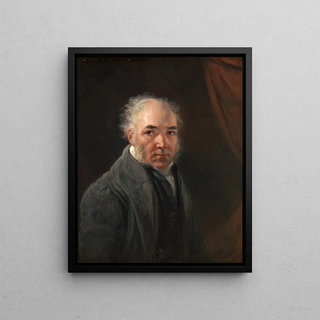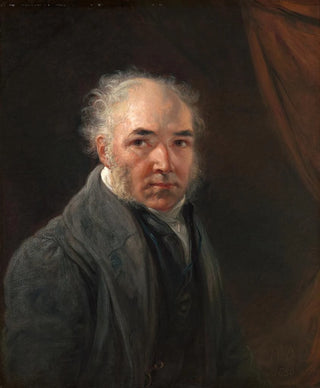Art print | Self-portrait - James Ward


View from behind

Frame (optional)
James Ward Autoportrait Art print - Captivating introduction
The James Ward Autoportrait, a hallmark of early 19th-century art, invites a fascinating dive into the complex universe of the artist. This painting, both introspective and bold, bears witness to an era when the artist was not content with merely depicting the external world but also sought to explore the depths of their being. Ward, a renowned British portrait painter, offers us here a vision of himself that goes beyond a simple reflection. This masterpiece, through its emotional intensity and technical mastery, captures attention and sparks curiosity, prompting viewers to question identity and self-perception.
Style and uniqueness of the work
The James Ward Autoportrait stands out for its rich and nuanced color palette, where dark tones contrast with luminous touches, illuminating the artist’s face in an almost theatrical manner. The composition is carefully orchestrated, with each element placed with precision that demonstrates Ward’s technical expertise. The facial details, from penetrating eyes to features marked by time, reveal a complex and introspective personality. The artist’s direct and honest gaze engages the viewer in a silent dialogue, an invitation to explore the thoughts and emotions within. This blend of realism and psychological depth gives the work a singularity that transcends a simple self-portrait, making it a reflection on art itself and the human condition.
The artist and his influence
James Ward, born in 1769, established himself as a major figure in the British artistic landscape. Trained at the Royal Academy, he developed a style that combines tradition and innovation, influenced by the great masters of the past while seeking to assert his own voice. His work goes beyond mere representation; it is part of a current of thought questioning the nature of art and the artist. Ward also played a key role in promoting portraiture as a genre, emphasizing not only external appearance but also the inner life of his subjects. His influence is still felt today, both in the world of painting and in the

Matte finish

View from behind

Frame (optional)
James Ward Autoportrait Art print - Captivating introduction
The James Ward Autoportrait, a hallmark of early 19th-century art, invites a fascinating dive into the complex universe of the artist. This painting, both introspective and bold, bears witness to an era when the artist was not content with merely depicting the external world but also sought to explore the depths of their being. Ward, a renowned British portrait painter, offers us here a vision of himself that goes beyond a simple reflection. This masterpiece, through its emotional intensity and technical mastery, captures attention and sparks curiosity, prompting viewers to question identity and self-perception.
Style and uniqueness of the work
The James Ward Autoportrait stands out for its rich and nuanced color palette, where dark tones contrast with luminous touches, illuminating the artist’s face in an almost theatrical manner. The composition is carefully orchestrated, with each element placed with precision that demonstrates Ward’s technical expertise. The facial details, from penetrating eyes to features marked by time, reveal a complex and introspective personality. The artist’s direct and honest gaze engages the viewer in a silent dialogue, an invitation to explore the thoughts and emotions within. This blend of realism and psychological depth gives the work a singularity that transcends a simple self-portrait, making it a reflection on art itself and the human condition.
The artist and his influence
James Ward, born in 1769, established himself as a major figure in the British artistic landscape. Trained at the Royal Academy, he developed a style that combines tradition and innovation, influenced by the great masters of the past while seeking to assert his own voice. His work goes beyond mere representation; it is part of a current of thought questioning the nature of art and the artist. Ward also played a key role in promoting portraiture as a genre, emphasizing not only external appearance but also the inner life of his subjects. His influence is still felt today, both in the world of painting and in the






